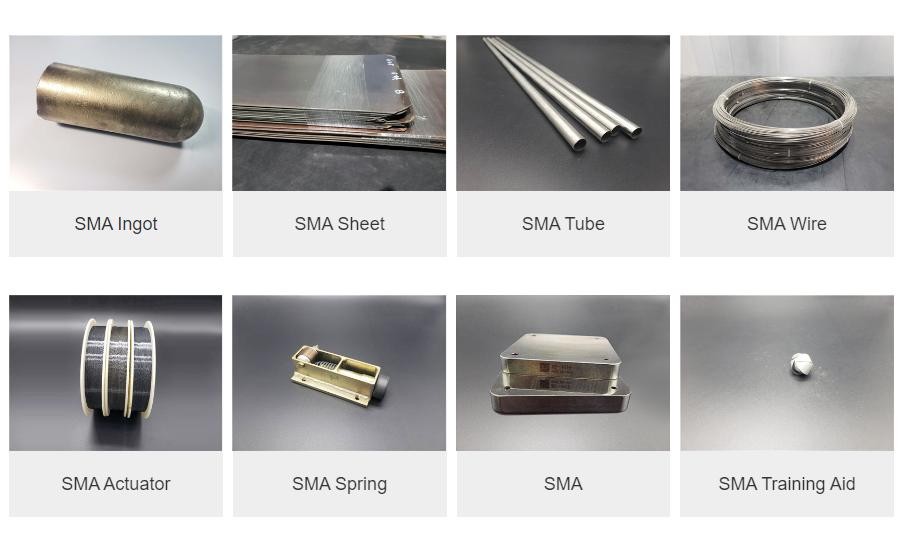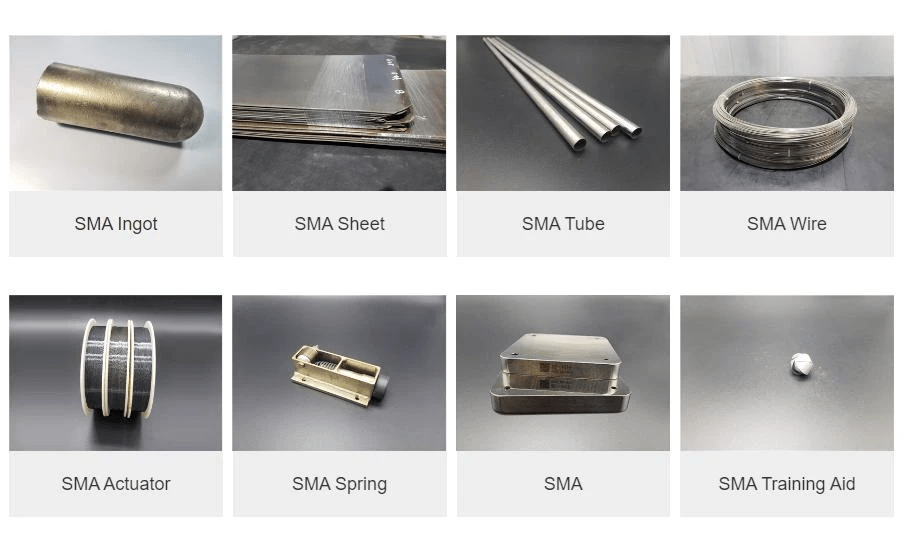Introduction

Regarding advanced materials for various applications, nitinol plate is a popular choice due to its unique properties and versatility. Nitinol alloys, primarily composed of nickel and titanium, offer exceptional shape memory and superelasticity. This makes them ideal for various industries, from medical to industrial. Understanding the different types of nitinol alloys and their applications is essential for harnessing the full potential of this remarkable material.
Understanding the Different Types of Nitinol Alloys
Nitinol alloys, known for their unique shape-memory properties, offer various applications in various industries.
- Nitinol wire: Used in actuators, sensors, and medical devices.
- Nitinol sheet: Ideal for shape-memory springs, medical stents, and orthodontic wires.
- Nitinol foil: Thin and flexible, perfect for micro actuators and sensors.
- Nitinol sheet metal: Used for larger-scale applications like heat exchangers and shape-memory structures.
Nitinol alloys' versatility and exceptional properties make them valuable in fields such as medicine, aerospace, and engineering.
Exploring the Applications of Nitinol Plates
Nitinol plates' applications are vast and diverse. Nickel plates have revolutionized the medical field from orthodontic archwires to stents used in minimally invasive surgeries. In industrial settings, nitinol plates are utilized in actuators, sensors, and other precision instruments due to their ability to return to a predetermined shape when heated.
Factors to Consider Before Buying Nitinol Plates
Nitinol plates offer unique properties for various applications. Here are essential factors to consider before purchasing:
- Size: Ensure the plate dimensions align with your specific requirements.
- Shape Memory Properties: Understand how the material will return to its original shape after deformation.
- Superelasticity: Assess the material's ability to withstand large deformations without permanent damage.
- Corrosion Resistance: Consider the environment where the plate will be used to ensure longevity.
- Cost-Effectiveness: Evaluate the cost of nitinol plates compared to alternative materials.
When selecting a supplier, prioritize those who adhere to strict quality standards to guarantee the performance and durability of your nitinol plates.
The Basics of Nitinol Plate

Nitinol plate is a type of shape memory alloy composed of nearly equal parts nickel and titanium. This unique combination allows nitinol plate to remember its original shape and return to it when heated, making it an incredibly versatile material for various applications.
What is
a Nitinol Plate?
Nitinol plate, also known as shape memory alloy, is a type of metal alloy that exhibits the unique properties of shape memory and superelasticity. This means the material can be deformed at one temperature and then return to its original shape upon heating. Due to its biocompatibility and flexibility, nitinol plate is commonly used in medical devices, such as stents and guidewires.
Properties and Characteristics of Nitinol Plate
Nitinol plate possesses several key properties, making it highly desirable for various applications. These include high flexibility, corrosion resistance, excellent fatigue life, and the ability to withstand high temperatures without permanent deformation. Additionally, the nitinol plate exhibits superelastic behavior, allowing it to undergo large deformations without experiencing plastic deformation.
Furthermore, nitinol plates' lightweight nature makes them ideal for applications where weight is a concern, such as aerospace or medical devices. Their biocompatibility also makes them suitable for medical implants, as they can safely interact with the human body without causing adverse reactions. In addition, the nitinol plate's shape memory effect allows it to return to its original shape after being deformed, making it useful for various engineering and biomedical applications.
Advantages of Using Nitinol Plate
Nitinol plate, a nickel-titanium alloy, offers many benefits, making it a valuable material in various industries. Its unique properties include:
- Flexibility and durability: Nitinol plate is known for its ability to bend and flex without breaking, making it ideal for applications requiring resilient components.
- Biocompatibility: Its compatibility with human tissue makes it suitable for medical devices and implants.
- Shape memory and superelasticity: Nitinol plates can return to their original shape after being deformed, a property essential for stents, actuators, and other applications.
These properties have made nitinol plate popular for innovative products and technologies across industries, from medical devices to robotics and aerospace engineering.
As we continue to explore the potential of nitinol plates, it is clear that this versatile material will play a significant role in shaping the future of technology and innovation.
Types of Nitinol Alloys

Nitinol alloys are a unique group of materials known for their shape memory and superelastic properties. These alloys are primarily composed of nickel and titanium, with varying percentages of each metal contributing to different properties and characteristics.
Exploring Different Types of Nitinol Alloys
Nitinol alloys offer various properties and applications due to their unique shape memory effect and superelasticity.
- Nitinol Titanium Alloys: These alloys have a higher percentage of titanium, making them more corrosion-resistant and suitable for medical implants.
- Nitinol Nickel Alloys: These alloys have a higher percentage of nickel, providing excellent superelasticity ideal for industrial applications such as actuators and sensors.
- Nitinol Alloys Based on Phase Transformation Temperature:
- Body Temperature Alloys: These alloys exhibit a shape memory effect at body temperature, making them suitable for medical devices like surgical tools, stents, and orthodontic wires.
- Higher Transition Temperature Alloys: These alloys are utilized in robotics and aerospace engineering applications where high-temperature superelasticity is required.
The diverse properties of nitinol alloys make them versatile materials with applications spanning from healthcare to advanced engineering.
Applications and Suitability of Nickel Plates
Nickel plates, a type of nitinol alloy, are widely used in various industrial applications due to their remarkable superelasticity. They are commonly employed in aerospace, automotive, and robotics industries for components that require precise shape memory characteristics.
Nickel plates are also utilized in the medical industry for applications such as orthodontic wires, stents, and other implantable devices. Their superelasticity allows them to withstand the stress and strain of bodily movement without losing their shape, making them an ideal material for medical devices. Additionally, their biocompatibility and corrosion resistance make them a safe and durable choice for use within the human body.
Understanding the Composition of Nitinol Wire
Nitinol wire is another important form of nitinol alloy widely used in medical devices due to its biocompatibility and superelasticity. Its composition typically consists of approximately 55-56% nickel and titanium balance, giving it the unique ability to return to its original shape after deformation.
By understanding the different types of nitinol alloys, such as nickel plates and nitinol wire, you can better appreciate their diverse applications across various industries while harnessing their unique properties for innovative solutions.
Selecting the Right Nitinol Plate

When choosing a nitinol plate, factors such as the required dimensions, shape, and surface finish must be considered. The specific application of the nitinol plate will also determine the appropriate thickness and strength needed for the material to perform optimally.
Factors to Consider When Choosing Nitinol Plate
Several factors must be carefully considered when selecting a nitinol plate to ensure its optimal performance and suitability for the intended application.
- Intended Application: Clearly define the specific use case for the nitinol plate, whether it's in medical devices, industrial machinery, or other fields. This will help determine the necessary material properties and requirements.
- Specific Requirements: Identify the critical factors such as temperature range, fatigue resistance, corrosion resistance, and biocompatibility that the nitinol plate must meet to function effectively in the given application.
- Manufacturing Process: Understand the techniques used to produce the nitinol plate, such as hot or cold working. This knowledge can provide insights into the material's quality, microstructure, and mechanical properties.
By carefully evaluating these factors, you can make an informed decision when selecting a nitinol plate that aligns with your specific needs and ensures its successful implementation in your project.
Tips for Finding a Reliable Nitinol Plate Supplier
When searching for a supplier of nitinol plates, it's important to look for a company with a proven track record of delivering high-quality materials. Reading customer reviews and seeking recommendations from industry experts can help identify reputable suppliers. Furthermore, ensuring that the supplier has adequate inventory and offers customization options is vital for meeting unique project needs.
In addition to considering the supplier's track record and customer reviews, evaluating their quality standards for nitinol plates is important. Look for suppliers that adhere to industry-specific quality certifications and standards, such as ISO 13485 or ASTM F2063, to ensure that the materials meet the necessary specifications for your project. This demonstrates a commitment to delivering reliable and consistent products, giving you peace of mind when choosing a supplier for your nitinol plate needs.
Understanding the Quality Standards for Nitinol Plate
Before making a purchase, it's essential to understand the quality standards that govern nitinol plate production. It's crucial to ensure that the material meets industry-specific certifications and complies with international standards for materials used in critical applications. This includes adherence to standards such as ASTM F2063 for medical-grade nitinol alloys and ASTM F2633 for industrial applications.
By considering these factors and tips when selecting a nitinol plate, you can ensure that you acquire a high-quality material that meets your project requirements while also finding a reliable supplier that adheres to stringent quality standards.
Applications of Nitinol Plate

Medical Applications of Nitinol Plate
Nitinol plate is widely used in the medical field due to its unique properties, such as shape memory and superelasticity. It is commonly used in orthodontic braces, stents, and surgical tools. The flexibility and biocompatibility of nitinol plate make it an ideal material for minimally invasive medical procedures.
The nitinol plate's ability to return to its original shape after being deformed makes it a valuable material for medical devices that need to adapt to the body's natural movements. This unique property allows orthodontic braces made from nitinol plates to apply constant, gentle pressure on teeth for more effective and comfortable realignment. Additionally, stents made from nitinol plates can be inserted into blood vessels in a compressed state and then expand to the appropriate size once in place, reducing the risk of complications during procedures.
Industrial Uses of Nitinol Plate
In the industrial sector, nitinol plate is utilized in a variety of applications, such as actuators, sensors, and aerospace components. Its high fatigue and corrosion resistance make it suitable for harsh industrial environments. Due to its shape memory properties, nitinol plate is also used in robotics and automation.
In addition to its use in actuators, sensors, and aerospace components, nitinol plates have also found applications in the medical industry, particularly in manufacturing medical devices such as stents and guidewires. The unique properties of nitinol, including its superelasticity and biocompatibility, make it an ideal material for these critical healthcare products. Its ability to withstand harsh conditions within the human body while maintaining its shape and memory characteristics has increased its popularity in medicine.
Innovations and Future Trends in Nitinol Plate
As technology advances, new innovations in nitinol plates continue to emerge. Researchers are exploring the potential use of nitinol titanium alloys in smart materials for self-healing structures and advanced electronics. Future trends indicate a shift towards more sustainable manufacturing processes using nitinol alloys.
By harnessing the unique properties of nitinol plate, both the medical and industrial sectors can benefit from its versatility and reliability. As advancements continue to unfold, the potential for new applications and innovations with nitinol alloys is vast. GEE SMA remains committed to providing high-quality nitinol materials for various industries worldwide.
Maintenance and Care for Nitinol Plate

Nitinol plates are durable and versatile, but proper maintenance and care are essential to ensure their longevity and performance. When handling nitinol plates, it is important to wear protective gloves to prevent contamination from oils or other substances on the skin. Additionally, using clean tools and equipment can help prevent scratches or damage to the surface of the nitinol plate.
Best Practices for Handling Nitinol Plate
Proper handling of nitinol plate also involves avoiding exposure to extreme temperatures or corrosive environments, as these can impact its shape memory properties. It is recommended to store the nitinol plate in a dry, cool area away from direct sunlight to prevent oxidation or degradation. By following these best practices, users can maintain the integrity of the nitinol plate for optimal performance in various applications.
Cleaning and Storage of Nitinol Foil
When cleaning and storing nitinol foil, it is important to use mild detergent solutions and soft cloths to avoid scratching or damaging the surface. After cleaning, thoroughly dry the nitinol foil before storing it in airtight containers or sealed bags to minimize exposure to moisture or contaminants. Proper storage conditions can help preserve the shape memory properties of nitinol foil for future use.
Avoiding Common Issues with Nitinol Sheet Metal
To avoid common issues with nitinol sheet metal, it is crucial to inspect the material for signs of damage or deformation before use. Any defects should be addressed promptly to prevent further complications during processing or application. Additionally, following manufacturer guidelines for bending, shaping, and heat treatment can help prevent issues such as cracking or loss of shape memory properties in nitinol sheet metal.
Make Informed Decisions When Purchasing Nitinol Plate

When purchasing nitinol plates, it's crucial to consider factors such as quality standards, supplier reliability, and specific application requirements. By understanding the different types of nitinol alloys and their properties, you can make informed decisions that align with your needs and expectations.
Harnessing the Potential of Nitinol Alloys
The potential of nitinol alloys is vast, with applications ranging from medical devices to industrial components. By harnessing the unique properties of nitinol titanium, such as shape memory and superelasticity, innovative solutions can be developed for various industries, driving progress and efficiency.
GEE SMA: Your Trusted Partner for High-Quality Nitinol Materials
GEE SMA is your trusted partner for high-quality nitinol materials. We offer a wide range of products, including nitinol plates, nickel plates, nitinol wire, sheet metal, foil, and more. GEE SMA is committed to excellence and customer satisfaction and provides reliable solutions for your nitinol alloy needs.

